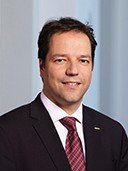Prof. Martin Frenz
Professor at University of Bern
Martin Frenz is professor for Biomedical Photonics at the University of Bern, Switzerland. He received the M.Sc. from the Albert-Ludwig University, Freiburg, Germany, in 1985 and the Ph.D. degree from the University of Bern in 1990. From 1990 to 2002 he headed the Laser Surgery Group at the Institute of Applied Physics of the University of Bern, working in the field of laser applications in medicine for therapy and diagnostics. From 1995 to 1996 he joined the Department of Biomedical Engineering at the University of Texas at Austin, USA. Since 2002 Dr. Frenz has been the director of the Biomedical Photonics department and since 2007 the director of the Institute of Applied Physics at the University of Bern. His research is directed toward the development of novel optical tomographic imaging modalities as well as laser procedures for diagnosis and therapeutic treatment of diseases. Emphasis is put on the development of optoacoustic and two-photon imaging techniques and the interactions of ultrashort near infrared lasers with biological soft matter. In addition, he is investigating structures and dynamics in biologically relevant soft condensed matter with photonic techniques such as photon-correlation and single-photon timing.
Prof. Marco Stampanoni
Professor atETH Zürich
With his team, Marco Stampanoni is working on novel X-ray based instruments and methods for non-invasive investigations of samples at various length scales, ranging from single cells up to humans. The group mainly develops around cutting-edge synchrotron facilities and translates the novel technologies on conventional X-ray sources. Research areas encompass phase contrast X-ray imaging and microscopy, realtime tomographic microimaging, nano-tomography and novel radiological methods for clinical applications and, more general, non-destructive testing.
Marco Stampanoni has been Assistant Professor (2008-2013), Associate Professor (2013-2017) and since 2017 Full Professor for X-Ray Imaging at ETH Zurich, within the Department of Information Technology and Electrical Engineering at ETH Zurich. His professorship is affiliated to the Institute of Biomedical Engineering of the University and ETH Zurich, where he leads the division for X-ray Imaging and Microscopy. At the Paul Scherrer Institut, he is the head of the X-ray tomography group at the Swiss Light Source (SLS).
Christof Aegerter
Professor atUniversity of Zurich
1991-1996 Studies of Physics, Mathematics and Astronomy, University of Zürich, Switzerland Diploma thesis in the group of Prof. H. Keller
1996-1998 PhD Thesis with Prof. H. Keller at the Physics Institute, University of Zürich, Switzerland
1999-2000 Postdoctorate with Prof. C.M. Surko, University of California San Diego, USA
2001-2004 Research Assistant with Prof. R. Griessen, Free University of Amsterdam, The Netherlands
2004-2007 Research Associate with Prof. G. Maret, University of Konstanz, Germany
2007- Privatdozent in Physics at the University of Konstanz, Germany
2008- Group Leader and Lecturer at the Physics Institute at the University of Zürich, Switzerland
Prof. Saverio Braccini
Professor Albert Einstein Center for Fundamental Physics (AEC), Laboratory for High Energy Physics (LHEP),
University of BernSaverio Braccini is Professor of experimental physics at the Albert Einstein Center for Fundamental Physics (AEC) - Laboratory for High Energy Physics (LHEP) of the University of Bern, where he leads the research group on medical applications of particle physics. He proposed the realisation of the medical cyclotron laboratory at the Bern University Hospital, an innovative facility for radioisotope production and multi-disciplinary research. He teaches general physics, medical radiation physics and radiation protection. He was formerly Technical Director of the Foundation for Oncological Hadrontherapy TERA at CERN in Geneva, where he contributed to the development of innovative accelerators and detectors for the treatment of tumours with hadron beams. In fundamental high energy physics, he contributed to experiments at the Large Electron Positron Collider (LEP) and at the Large Hadron Collider (LHC) at CERN.
Nathan Torelli
PHD StudentUniversity of Zurich






